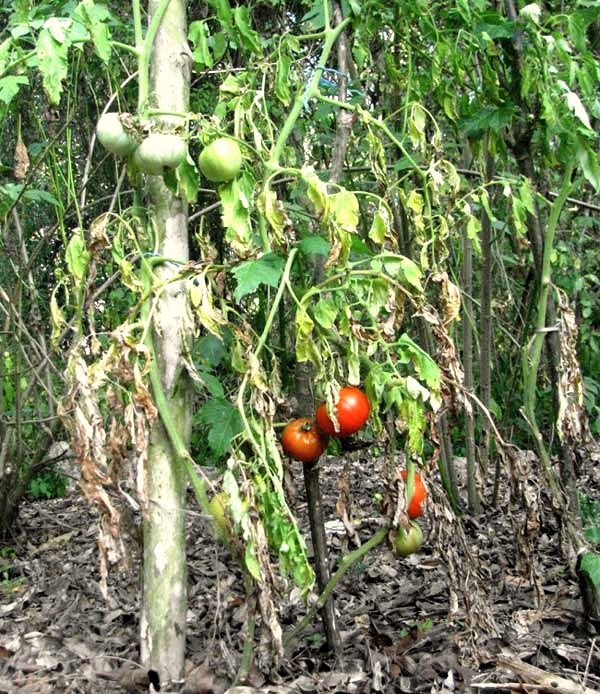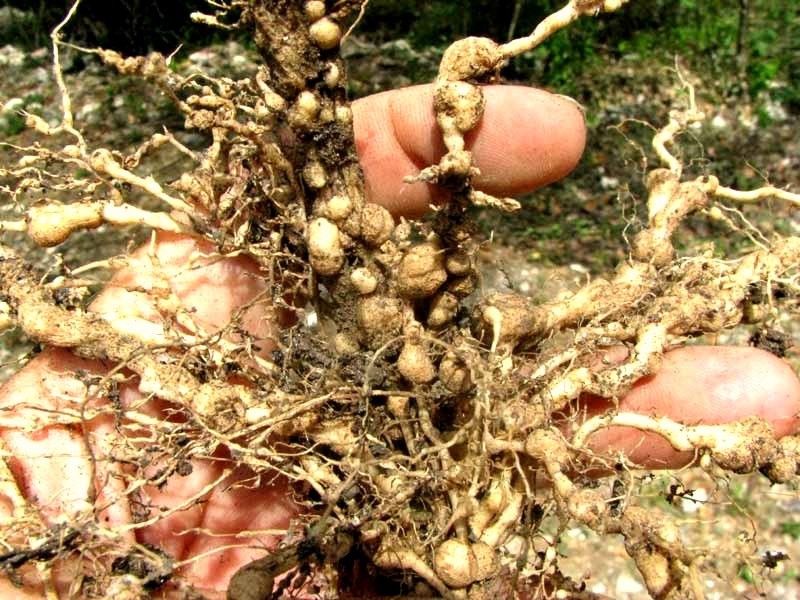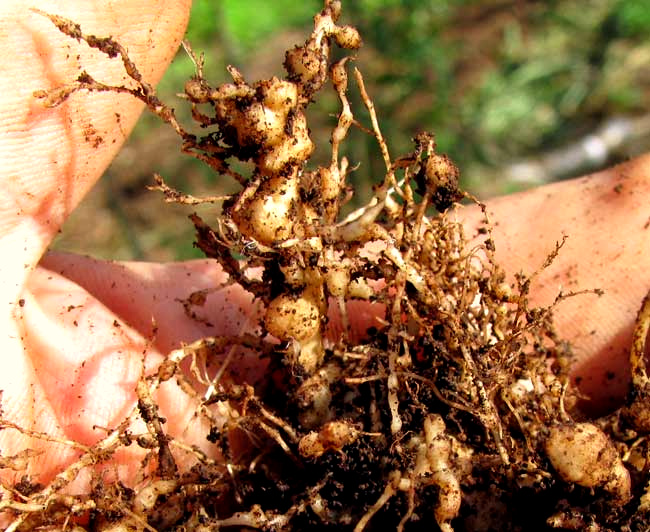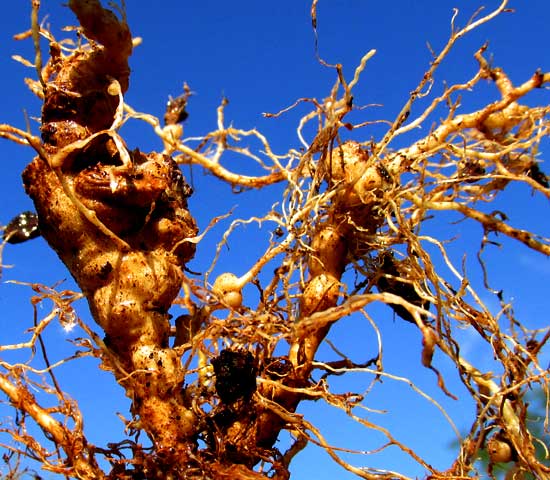Excerpts from Jim Conrad's
Naturalist Newsletter

from the March 11, 2012 Newsletter issued from Hacienda Chichen Resort beside Chichén Itzá Ruins; limestone bedrock; elevation ~39m (~128ft), N20.675°, W88.569°; central Yucatán state, MÉXICO
NEMATODES: A TOMATO DISASTER
My glorious tomato vines, now over seven feet high, (2m) are dying. You can see what one vine looks like above.
I knew I had trouble two weeks ago when suddenly the vines' upper leaves wilted as if the plants needed watering, though I watered them well each day. Last week the vines' lowest leaves began turning yellow, then quickly became dry and brown, and began falling off. Now all the leaves on the vines' lower half are dead and it's clear that the whole vines soon will die.
Tomato plants are subject to various wilting diseases, so on the Internet I studied their symptoms closely. The fungal diseases of Verticillium Wilt and Fusarium Wilt both cause symptoms just like I've described. However, Verticillium Wilt appears to favor cooler climes, and a symptom of both Verticillium and Fusarium Wilts is that the piths of stems of sick plants at ground level discolor brown. The piths of my dying plants looked healthily white.
But uprooting a plant to cut into its stem to see what color its pith was enabled me to see what's shown below:

Nematodes! A tomato's roots are supposed to be slender and much branched into fine rootlets, but just look at how these roots are thick and gnarly with swellings. I recognized the growths as the work of nematodes because in 2010 soon after arriving at the Hacienda I tried to grow tomatoes, but nematodes killed them all. This year, remembering that debacle, I germinated and potted the plants in soil from where the gardeners had burned a pile of brush, thus surely sterilizing the soil, and similarly the seedlings were planted where previously an even bigger brush pile had been burned. These nematodes are tougher than I thought! And the Hacienda must be nematode paradise.
Nematodes are microscopic, wormlike creatures.
The afternoon of the morning after the picture of my ripe tomatoes was taken, birds hollowed out my prizes. So there's something to think about even if your plants don't succumb to nematodes.
from the August 1, 2010 Newsletter issued from Hacienda Chichen Resort beside Chichén Itzá Ruins, central Yucatán, MÉXICO; limestone bedrock, elevation ~39m (~128ft), ~N20.676°, ~W88.569°
TOMATO ROOT NEMATODES
Though a fungal disease is indeed attacking the tomatoes now I realize that most of the damage I thought was fungal is caused by nematodes. That became apparent when one plant had curled up and withered so that I decided to just pull it up and get rid of it. As soon as the roots were exposed, I saw what's shown below:

At first I hoped that those root knots were beneficial nitrogen-fixing nodules. However, you expect nodules on members of the Bean Family, pines and a few other things. On the Internet I can't find anyone saying that tomato roots can have nitrogen-fixing nodules. Also, nitrogen-fixing nodules are attached to a root's side, like a slender, floppy wart on someone's neck, but you can see that the tomato's knots are simply swellings of the root itself, not attached at the side.
from the May 21, 2017 Newsletter issued from Rancho Regensis north of Valladolid, Yucatán, MÉXICO;
elevation ~40m (~130 ft), N~20.876°, W~88.170°
NEMATODES ON OTHER PLANTS

If you compare the above root-knots found on a withering chili pepper plant I pulled up this week in my garden, you'll see that they're the same as those at the top of this page, found on a tomato plant.
In fact, this week I may have made a major breakthrough with regard to gardening on the Yucatan's thin, limestone-based soil, at least during the dry season. For, once I realized that my chili peppers had nematodes, I began pulling up my runty, wilting Zucchini, my dying cucumber vines, and other cultivars of poorly producing pepper plants, and they all displayed nematode-caused root-knots.
The breakthrough is in discovering that this nematode problem is not limited to the Chichén Itzá area, nor just to tomato plants, but possibly it's an endemic problem throughout the Yucatan affecting many cultivars. My Zucchini germinated very well, grew into robust plants, began producing flowers, and then suddenly fizzled, stopped growing, the flowers fell off... and then I pulled them up and found nematode-caused root-knots.
I'm growing about five different pepper cultivars. Only one is thriving, and that's the one the local Maya traditionally grow. It's a kind of sweet bell pepper that is smaller and with more numerous ribs than those we know in the North. It's not nearly as good tasting and attractive as what we grow in the North, but at least it's not affected by nematode-caused root-knots. I suspect that many Northern cultivars that are tried and which fail in the Yucatan are succumbing to nematodes.
Of course there are chemicals for controlling nematodes, but here we're organic. I read that the best approach to controlling nematodes is to enrich a soil and develop good soil structure. All soils have nematodes in them but usually naturally occurring soil organisms prey on them, keeping them under control. When soils are abused -- as ours was by cattle ranching proceeding our gardening efforts -- nematode populations can get out of hand. Therefore, I'm enriching the soil with livestock manure and compost, building up the soil's organic matter, and hoping that eventually our soil ecology will get back in line, and the nematode population will decline to acceptable levels.